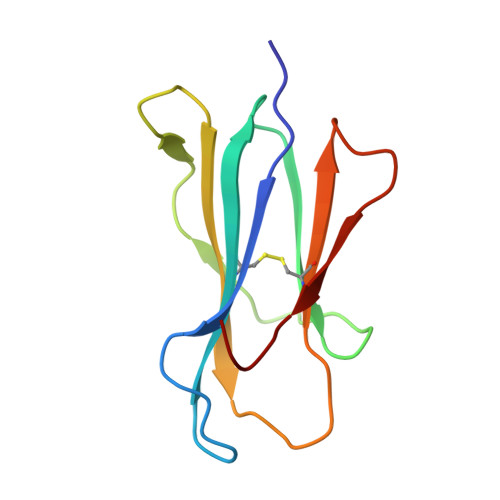Crystal structure and immunoglobulin G binding properties of the human major histocompatibility complex-related Fc receptor(,).
West Jr., A.P., Bjorkman, P.J.(2000) Biochemistry 39: 9698-9708
- PubMed: 10933786
- DOI: https://doi.org/10.1021/bi000749m
- Primary Citation of Related Structures:
1EXU - PubMed Abstract:
The neonatal Fc receptor (FcRn) performs two distinct but related functions: transport of maternal immunoglobulin G (IgG) to pre- or neonatal mammals, thus providing passive immunity, and protection of IgG from normal serum protein catabolism. FcRn is related to class I MHC proteins but lacks a functional peptide binding groove. The crystal structure of human FcRn has been determined at 2.7 A resolution and compared to the previously described structure of rat FcRn [Burmeister et al. (1994) Nature 372, 336-343] and to the structures of MHC and MHC-related proteins. Human FcRn is structurally similar to the rat receptor but does not form receptor dimers in the crystals as observed in crystals of rat FcRn. The interaction between human FcRn and IgG was characterized by determining the binding stoichiometry using equilibrium gel filtration and by deriving binding affinities for the different human IgG subclasses using a surface plasmon resonance assay. Like rat and mouse FcRn, human FcRn interacts with IgG with a 2:1 receptor:ligand stoichiometry. The binding of human FcRn to the four human IgG subclasses shows subclass and allotype variations but no clear subclass affinity differences that correlate with serum half-lives. The structure of human FcRn and studies of its ligand binding are relevant to current efforts to use FcRn-mediated regulation of IgG half-life in serum to increase the lifetimes of antibody-based therapeutics.
- Division of Biology 156-29 and Howard Hughes Medical Institute, California Institute of Technology, Pasadena, California 91125, USA.
Organizational Affiliation:


















